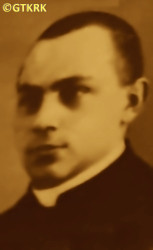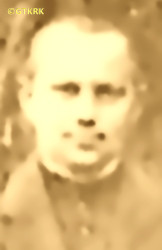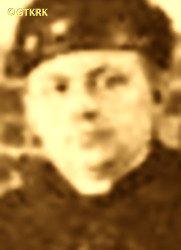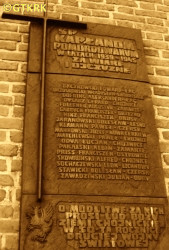Roman Catholic
St Sigismund parish
05-507 Słomczyn
85 Wiślana Str.
Konstancin deanery
Warsaw archdiocese, Poland
full list:
displayClick to display full list

searchClick to search full list by categories
wyświetlKliknij by wyświetlić pełną listę po polsku

szukajKliknij by przeszukać listę wg kategorii po polsku

Martyrology of the clergy — Poland
XX century (1914 – 1989)
personal data
surname
ZAWADZIŃSKI
forename(s)
Julian Paul (pl. Julian Paweł)
forename(s)
versions/aliases
Julius (pl. Juliusz)
function
diocesan priest
creed
Latin (Roman Catholic) Church RCmore on
en.wikipedia.org
[access: 2014.09.21]
diocese / province
Culm (Chełmno) diocesemore on
pl.wikipedia.org
[access: 2012.11.23]
date and place
of death
01.11.1939

Igłytoday: neighborhood in Chojnice, Chojnice urban gm., Chojnice pov., Pomerania voiv., Poland
more on
en.wikipedia.org
[access: 2021.09.02]
alt. dates and places
of death
29.10.1939, 11.1939
details of death
After German and Russian invasion of Poland in 09.1939 and start of the World War II, after start of German occupation, arrested on 26.10.1939 by the members of the genocidal formation Germ. Volksdeutscher Selbstschutz.
Held in IL Konitz internment camp in Chojnice.
From there taken to an execution site.
The arrests, which began in Chojnice immediately after the German troops entered the city on 02.09.1939, were initially carried out by units of the Germ. Wehrmacht (Eng. Armed Forces), and after a few days by the genocidal units of the Germ. Einsatzgruppen (Eng. Operational Groups), subordinated to the Germ. Reichssicherheitshauptamt (Eng. Reich Main Security Office), i.e. RSHA, whose task was to „secure the rear” of the Germ. 4th Armee (Eng. 4th Army), that was taking part in the attack on Poland. Almost simultaneously, the genocidal unit of the Germ. Volksdeutscher Selbstschutz (Eng. Ethnic Germans Self‐Defense), whose members were Germ. Volksdeutsche (Eng. Ethnic Germans), i.e. representatives of the German minority in Poland from Chojnice and the surrounding area, supervised by the paramilitary, genocidal Germ. Die Schutzstaffel der NSDAP (Eng. NSDAP Protection Unit), i.e. «SS», subordinate in turn to the ruling National Socialist German Workers' Party NSDAP. The headquarters of the 4th Inspectorate of the Germ. Volksdeutscher Selbstschutz was located in Chojnice.
The victims were people who were included in the one of the so‐called Germ. Sonderfahndungsliste (Eng. Special Wanted List), i.e. a proscription list of names of „enemies of the Reich”, prepared before the German aggression, or on some other proscription list, drawn up ad hoc by the local Germ. Volksdeutsche.
Those arrested were placed in the Germ. „Internierungslager” (Eng. „internment camp”) IL Konitz, established in the buildings of the Polish „National Social Welfare Institutions ‐ Correctional Work House”. When the Germans attacked Poland, the poor who lived in one of the blocks were evacuated from the Institution. Criminals sentenced to forced labor, who occupied the second block, escaped. Only the mentally ill remained, occupying the third block, known as the Hospital for the Mentally Ill, a branch of the Psychiatric Institution in Kocborowo.
And it was these sick people who became the first victims of IL Konitz. As part of the «Aktion T4» program, i.e. Germ. „Vernichtung von lebensunwertem Leben” (Eng. „elimination of life unworthy of life”), 218 sick people were taken to fields located in a valley near the village of Igły, c. 2.5 km north of the center of Chojnice. There, in trenches built by the Polish army in the summer of 1939, which quickly acquired the local name „Valley of Death”, they were murdered.
The next group of victims were local Poles. As part of the Germ. «Intelligenzaktion» (Eng. Intelligence Action), i.e. the extermination of the Polish intelligentsia and leadership classes of Pomerania, the Germ. Volksdeutscher Selbstschutz murdered, from 20.10.1939 till 12.1939, several hundred representatives of local Polish elites, including members of the Polish Western Union PZZ.
The victims were brought in prob. by trucks. On site, were forced to remove their clothes and surrender their documents and personal belongings. Finally, were lined up over trenches and shot — with Mauser rifles, Walther PPK, Parabellum P08, or Browning pistols, caliber 7.62 mm and 9 mm — in the back of the head. Those who survived the first volley were finished off in the pits. The pits were filled in, and the ground was leveled.
Among the victims were c. nine Catholic priests.
In total, the Germans murdered on the Igły fields c. 500 inhabitants of Chojnice and vicinity.
Additionally, in 01.1945, the Germans murdered another 1,000‐1,300 people there.
cause of death
mass murder
perpetrators
Germans
sites and events
Igielskie FieldsClick to display the description, IL KonitzClick to display the description, «Intelligenzaktion»Click to display the description, Reichsgau Danzig‐WestpreußenClick to display the description, Ribbentrop‐MolotovClick to display the description, Pius XI's encyclicalsClick to display the description
date and place
of birth
12.06.1900

Skrzynkitoday: Stelchno gm., Świecie pov., Kuyavia‐Pomerania voiv., Poland
more on
pl.wikipedia.org
[access: 2021.12.18]
parents
ZAWADZIŃSKI Paul
🞲 ?, ? — 🕆 ?, ?

MURAWSKA Martha
🞲 ?, ? — 🕆 ?, ?
presbyter (holy orders)
ordination
14.06.1924

Pelplintoday: Pelplin gm., Tczew pov., Pomerania voiv., Poland
more on
en.wikipedia.org
[access: 2021.05.06]
St Barbara RC chapelmore on
pl.wikipedia.org
[access: 2021.12.19] (in Theological Seminary)
positions held
1929 – 1939
curatus/rector/expositus — Odrytoday: Czersk gm., Chojnice pov., Pomerania voiv., Poland
more on
en.wikipedia.org
[access: 2022.01.28] ⋄ Assumption of the Blessed Virgin Mary RC curacy ⋄ Czersktoday: Czersk gm., Chojnice pov., Pomerania voiv., Poland
more on
en.wikipedia.org
[access: 2021.09.02] RC deanery — from 1937 titular parish priest; also: church builder
1926 – 1929
vicar — Jeżewotoday: Jeżewo gm., Świecie pov., Kuyavia‐Pomerania voiv., Poland
more on
en.wikipedia.org
[access: 2021.09.02] ⋄ Holy Trinity RC parish ⋄ Świecietoday: Świecie gm., Świecie pov., Kuyavia‐Pomerania voiv., Poland
more on
en.wikipedia.org
[access: 2021.09.02] RC deanery
1924 – 1926
vicar — Kamień Pomorskitoday: Kamień Krajeński, Kamień Krajeński gm., Sępólno Krajeńskie pov., Pomerania voiv., Poland
more on
en.wikipedia.org
[access: 2021.09.02] ⋄ Blessed Virgin Mary and St Peter and St Paul the Apostles RC parish ⋄ Kamień Pomorskitoday: Kamień Krajeński, Kamień Krajeński gm., Sępólno Krajeńskie pov., Pomerania voiv., Poland
more on
en.wikipedia.org
[access: 2021.09.02] RC deanery
1920 – 1924
student — Pelplintoday: Pelplin gm., Tczew pov., Pomerania voiv., Poland
more on
en.wikipedia.org
[access: 2021.05.06] ⋄ philosophy and theology, Theological Seminary
others related
in death
BĄCZKOWSKIClick to display biography Bernard Paul, DYSARZClick to display biography Gerard, KLAMANNClick to display biography Paul John, MAŃKOWSKIClick to display biography Joseph Peter, MARCHLEWSKIClick to display biography Paul Peter, PAKALSKIClick to display biography Albin, PRISSClick to display biography Francis Felix, STAWICKIClick to display biography Boleslav, BRZÓSKOWSKIClick to display biography Vladislav
sites and events
descriptions
Igielskie Fields: In „Death Valley” n. Chojnice, as part of extermination of the Polish intelligentsia in Pomerania called «Intelligenzaktion» — in 1939, from 20.10.1939 till 12.1939 members of the genocidal German paramilitary organization Volksdeutscher Selbstschutz murdered c. 500 inhabitants of Chojnice and surrounding villages — mainly representatives of local intelligentsia and patients of the Chojnice psychiatric institute, branch of Kocborowo institute, during «Aktion T4» — Germ. „Vernichtung von lebensunwertem Leben” (Eng. „elimination of live not worth living”) extermination program. The victims — among them c. 9 Catholic priests — had to line up over the shooting ditches, take of their coats and jackets. Shots were fired at the back of their heads and bodies fell down themselves onto the ditches. In 01.1945 Germans murdered there additional 1,000‐1,300 victims. (more on: pl.wikipedia.orgClick to attempt to display webpage
[access: 2012.11.23])
IL Konitz: Germ. „Internierungslager” (Eng. „Internment camp”) set up by the Germans on c. 02.09.1939, immediately after the occupation of Chojnice and the beginning of the German occupation, intended for the inhabitants of Chojnice and the Chojnice poviat. The camp — until 07.09.1939, subordinated to the German army Wehrmacht, and then managed by officers of the genocidal organization Germ. Einsatzgruppen (Eng. Operational Groups), subordinated to the Germ. Reichssicherheitshauptamt RSHA (Eng. Main Reich Security Office) — was organized on the premises of the Juvenile Reformatory Institute in Chojnice. It operated till the end of 11.1939. At least 2,000 Poles were held there, mainly representatives of the local intelligentsia, as well as members of Polish patriotic organizations, e.g. Polish Western Union. Most of them, along with c. 215 mentally ill children from the National Social Welfare Institution in Chojnice (a branch of the psychiatric hospital in Kocborowo), were murdered — as part of the „Intelligenzaktion” — including at the nearby execution site at Pola Igielskie. In the years 1941‐1943, a transit camp for Poles destined for a slave labor in Germany. (more on: www.sdnchojnice.plClick to attempt to display webpage
[access: 2013.12.04])
«Intelligenzaktion»: German: «Intelligenzaktion» (English: „Intelligence Action”) — a German program of extermination of the Polish elite, mainly the intelligentsia and leadership layers, carried out from the beginning of the occupation in w 09.1939 to 04.1940, mainly in territories directly annexed to Germany, but also in the so‐called Germ. Generalgouvernement (Eng. General Governorate), where it was called «AB‐aktion». In the first phase, immediately after the beginning of the German occupation, during military operations carried out by the Germ. Wehrmacht (Eng. Armed Forces) and the genocidal units of the Germ. Einsatzgruppen (Eng. Operational Groups) of the Germ. Sicherheitspolizei (Eng. Security Police), i.e. SiPo, and Germ. Sicherheitsdienst des Reichsführers SS (Eng. Security Service of the Reichsführer SS), i.e. SD, organized by the Germ. Reichssicherheitshauptamt (Eng. Reich Main Security Office), i.e. RSHA, which followed the troops, carried out under the Germ. Unternehmen „Tannenberg” (Eng. Operation „Tannenberg”) — based on the so‐called Germ. Sonderfahndungsliste (Eng. Special Wanted Lists), i.e. proscription lists of Poles considered particularly dangerous to the Third Reich, prepared by the Zentralstelle II/P (Polen) unit of the German RSHA. Later, implemented by the German civilian occupation authorities and the genocidal unit of the Germ. Volksdeutscher Selbstschutz (Eng. Ethnic Germans Self‐Defense), whose members were Germ. Volksdeutsche (Eng. Ethnic Germans), i.e. representatives of the German minority in Poland. According to various sources, these lists, at the beginning of 09.1939, could have contained the details of 61,000—88,000 „dangerous” Poles — although these figures cannot be confirmed. In total, during this genocide, c. 50,000 teachers, Catholic priests, representatives of the landed gentry, freelancers, social and political activists, and retired military personnel were systematically and methodically murdered. Another 50,000 were sent to concentration camps, where only a negligible percentage survived. (more on: en.wikipedia.orgClick to attempt to display webpage
[access: 2014.10.04])
Reichsgau Danzig‐Westpreußen: After the Polish defeat in the 09.1939 campaign, which was the result of the Ribbentrop‐Molotov Pact and constituted the first stage of World War II, and the beginning of German occupation in part of Poland (in the other, eastern part of Poland, the Russian occupation began), the Germans divided the occupied Polish territory into five main regions (and a few smaller). The largest one was transformed into Germ. Generalgouvernement (Eng. General Governorate), intended exclusively for Poles and Jews and constituting part of the so‐called Germ. Großdeutschland (Eng. Greater Germany). Two were added to existing German provinces. From two other separate new provinces were created. Vistula Pomerania region was one of them, incorporated into Germany on 08.10.1939, by decree of the German leader Adolf Hitler (formally came into force on 26.10.1939), and on 02.11.1939 transformed into the Germ. Reichsgau Danzig‐Westpreußen (Eng. Reich District of Gdańsk‐West Prussia) province, in which the law of the German state was to apply. The main axis of the policy of the new province, the territory of which the Germans recognized as the Germ. „Ursprünglich Deutsche” (Eng. „natively German”), despite the fact that 85% of its inhabitants were Poles, was Germ. „Entpolonisierung” (Eng. „Depolonisation”), i.e. forced Germanization. C. 60,000 Poles were murdered in 1939‐1940, as part of the Germ. „Intelligenzaktion”, i.e. extermination of Polish intelligentsia and ruling classes, in c. 432 places of mass executions — including c. 220 Polish Catholic priests. The same number were sent to German concentration camps, from where few returned (over 300 priests were arrested, of whom c. 130 died in concentration camps). C. 124,000‐170,000 were displaced, including c. 90,000 to the Germ. Generalgouvernement. Poles were forced en masse to sign the German nationality list, the Germ. Deutsche Volksliste DVL. Polish children could only learn in German. It was forbidden to use the Polish language during Catholic Holy Masses and during confession. Polish landed estates were confiscated..To further reduce the number of the Polish population, Poles were sent to forced labor deep inside Germany. The remaining Poles were treated as low‐skilled labor, isolated from the Germans and strictly controlled — legally, three or three of them could only meet together, even in their own apartments. Many were conscripted into the German Wehrmacht army. After the end of hostilities of World War II, the overseer of this province, the Germ. Reichsstatthalter (Eng. Reich Governor) and the Germ. Gauleiter (Eng. district head) of the German National Socialist Party, Albert Maria Forster, was executed. (more on: en.wikipedia.orgClick to attempt to display webpage
[access: 2024.06.24])
Ribbentrop‐Molotov: Genocidal Russian‐German alliance pact between Russian leader Joseph Stalin and German leader Adolf Hitler signed on 23.08.1939 in Moscow by respective foreign ministers, Mr. Vyacheslav Molotov for Russia and Joachim von Ribbentrop for Germany. The pact sanctioned and was the direct cause of joint Russian and German invasion of Poland and the outbreak of the World War II in 09.1939. In a political sense, the pact was an attempt to restore the status quo ante before 1914, with one exception, namely the „commercial” exchange of the so‐called „Kingdom of Poland”, which in 1914 was part of the Russian Empire, fore Eastern Galicia (today's western Ukraine), in 1914 belonging to the Austro‐Hungarian Empire. Galicia, including Lviv, was to be taken over by the Russians, the „Kingdom of Poland” — under the name of the General Governorate — Germany. The resultant „war was one of the greatest calamities and dramas of humanity in history, for two atheistic and anti‐Christian ideologies — national and international socialism — rejected God and His fifth Decalogue commandment: Thou shall not kill!” (Abp Stanislav Gądecki, 01.09.2019). The decisions taken — backed up by the betrayal of the formal allies of Poland, France and Germany, which on 12.09.1939, at a joint conference in Abbeville, decided not to provide aid to attacked Poland and not to take military action against Germany (a clear breach of treaty obligations with Poland) — were on 28.09.1939 slightly altered and made more precise when a treaty on „German‐Russian boundaries and friendship” was agreed by the same murderous signatories. One of its findings was establishment of spheres of influence in Central and Eastern Europe and in consequence IV partition of Poland. In one of its secret annexes agreed, that: „the Signatories will not tolerate on its respective territories any Polish propaganda that affects the territory of the other Side. On their respective territories they will suppress all such propaganda and inform each other of the measures taken to accomplish it”. The agreements resulted in a series of meeting between two genocidal organization representing both sides — German Gestapo and Russian NKVD when coordination of efforts to exterminate Polish intelligentsia and Polish leading classes (in Germany called «Intelligenzaktion», in Russia took the form of Katyń massacres) where discussed. Resulted in deaths of hundreds of thousands of Polish intelligentsia, including thousands of priests presented here, and tens of millions of ordinary people,. The results of this Russian‐German pact lasted till 1989 and are still in evidence even today. (more on: en.wikipedia.orgClick to attempt to display webpage
[access: 2015.09.30])
Pius XI's encyclicals: Facing the creation of two totalitarian systems in Europe, which seemed to compete with each other, though there were more similarities than contradictions between them, Pope Pius XI issued in 03.1937 (within 5 days) two encyclicals. In the „Mit brennender Sorge” (Eng. „With Burning Concern”) published on 14.03.1938, condemned the national socialism prevailing in Germany. The Pope wrote: „Whoever, following the old Germanic‐pre‐Christian beliefs, puts various impersonal fate in the place of a personal God, denies the wisdom of God and Providence […], whoever exalts earthly values: race or nation, or state, or state system, representatives of state power or other fundamental values of human society, […] and makes them the highest standard of all values, including religious ones, and idolizes them, this one […] is far from true faith in God and from a worldview corresponding to such faith”. On 19.03.1937, published „Divini Redemptoris” (Eng. „Divine Redeemer”), in which criticized Russian communism, dialectical materialism and the class struggle theory. The Pope wrote: „Communism deprives man of freedom, and therefore the spiritual basis of all life norms. It deprives the human person of all his dignity and any moral support with which he could resist the onslaught of blind passions […] This is the new gospel that Bolshevik and godless communism preaches as a message of salvation and redemption of humanity”… Pius XI demanded that the established human law be subjected to the natural law of God , recommended the implementation of the ideal of a Christian state and society, and called on Catholics to resist. Two years later, National Socialist Germany and Communist Russia came together and started World War II. (more on: www.vatican.vaClick to attempt to display webpage
[access: 2023.05.28], www.vatican.vaClick to attempt to display webpage
[access: 2023.05.28])
sources
personal:
orka2.sejm.gov.plClick to attempt to display webpage
[access: 2012.12.28], www.niedziela.plClick to attempt to display webpage
[access: 2012.12.28], czersk.naszemiasto.plClick to attempt to display webpage
[access: 2013.01.26], www.kpbc.ukw.edu.plClick to attempt to display webpage
[access: 2014.10.04]
bibliographical:
„Biographical dictionary of priests ordained in the years 1921‐1945 working in the Chełmno diocese”, Fr Anastasius Nadolny, prof., Bernardinum publishing house 2021
original images:
plus.pomorska.plClick to attempt to display webpage
[access: 2018.11.18], plus.pomorska.plClick to attempt to display webpage
[access: 2018.11.18], gdziebylec.plClick to attempt to display webpage
[access: 2019.11.11]
LETTER to CUSTODIAN/ADMINISTRATOR
If you have an Email client on your communicator/computer — such as Mozilla Thunderbird, Windows Mail or Microsoft Outlook, described at WikipediaPatrz:
en.wikipedia.org, among others — try the link below, please:
LETTER to CUSTODIAN/ADMINISTRATORClick and try to call your own Email client
If however you do not run such a client or the above link is not active please send an email to the Custodian/Administrator using your account — in your customary email/correspondence engine — at the following address:

giving the following as the subject:
MARTYROLOGY: ZAWADZIŃSKI Julian Paul
To return to the biography press below:
 Click to return to biography
Click to return to biography












